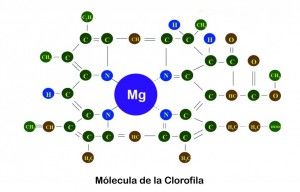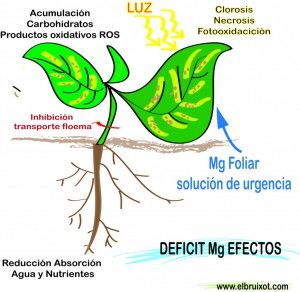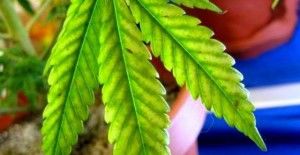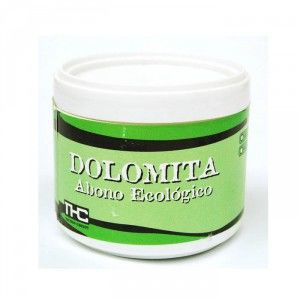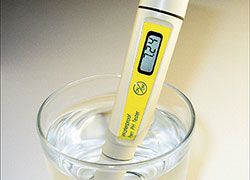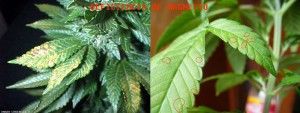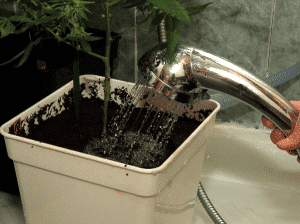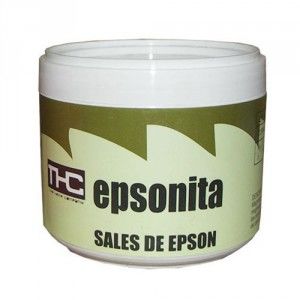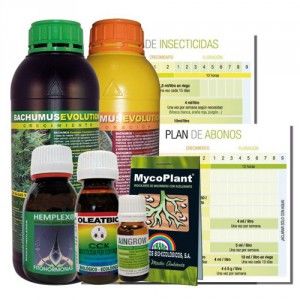The lack or excess of this chemical in the plant will mark its development, it is essential for it. Must be present at all stages of life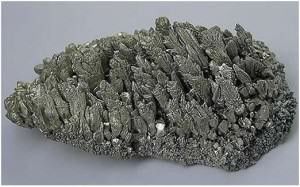
As is the case with humans and plants, in short, all living things, the marijuana plant needs certain elements, vitamins and minerals for proper development. Otherwise, it can not only sick but even die.
Of course, some are more important than others and roughly predominate depending on the stage of development or growth of the plant. However, there are elements that must be present throughout the entire plant life: this is the case of magnesium.
What is magnesium?
It is a chemical element that, in the case of the marijuana plant, it acts as a secondary nutrient that has to be, as mentioned, present in all phases of the life of our plant and abundantly, but of course , 
The magnesium is the central atom in chlorophyll and is essential for our plant can absorb sunlight properly. In addition, also it has the function of neutralizing chemicals and the plant produces hormone acts as activator.
The marijuana plant absorb magnesium better or worse, depending on the substrate that is in the soil, so it is very important the perfect balance between magnesium plant will absorb from the soil or land that is in the pot and its missing; it will be that we have to add manually, with different techniques.
In this sense and not to control the levels of magnesium, the most common problems you may experience a marijuana plant is the lack and to a lesser extent the excess.
Here’s how to know that this is happening to our plant, what the consequences are and how to fix it.
Magnesium deficiency
How do we know if our plant suffers magnesium deficiency? It is visually quite simple: the older leaves have a sort of yellow dots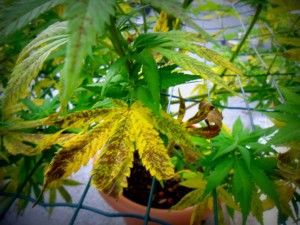
This phenomenon occurs regularly when the soil pH is below 7.0, especially if we are talking about indoor growing in pot. This makes for a high calcium concentration and thus said magnesium deficiency occurs. Another triggers occurs when this gap fertilize excessively with potassium and magnesium deficiency may be even higher. Excessive moisture also leads to the same phenomenon, as the plant is unable to absorb magnesium we give it. The same applies to the low temperatures.
In the first case, what we do is increase the pH level, especially if it is below 5.0. by dolomite limestone. This we take them out before growing, and mix with the amount of corresponding substrate, because as we mentioned earlier, that there is neither lack nor excess, a good balance between magnesium and sulfate is necessary. If you had not dolomite limestone can be included in irrigation other products containing and thus, better dosing quantities.
At Piensa en Verde we have Dolomite excellent quality (belongs to the house of fertilizers THC) and organic type, used to correct the levels of calcium and magnesium in the soil in which we have our marijuana plant, besides regulating ph levels in poor soils. Therefore it performs two functions in one and all without forgetting that favors the activity of beneficial bacteria and other microorganisms to the marijuana plant.
The time when the Dolomite works more efficiently is when we add it to the substrate, in the land before planting seeds, as we recommended at the beginning of this section. In this case, you must add a dolomite gram per liter of soil.
Returning to the above cases, if our plant lacks calcium due to excessive
In the event that we are facing a problem related to low temperatures, the solution is also simple: Simply place a heat source, until our growing area has an average temperature of 18 degrees (never lower) by night and about 24 during the day.
If magnesium deficiency is important and as an intervention of “urgency” or “shock”, it is recommended to adjust the pH of the soil of the land to 6.5 points and in case you have an indoor growing hydroponics, 5.5, about five days.
And, what happens if our plant is in the process of flowering and lacks magnesium? This happens at this stage is really dangerous because we’re about to get the result we want and if we do not control the level of magnesium in plant, this can die, after all that has taken us to reach this stage.
Something that occurs normally by excess nutrients such as potassium or calcium. And in this stage of life of a marijuana plant, it needs an abundance of nutrients to give odors and properties expected of all plant quality. However, in excess, they can stop the absorption of magnesium and affect our plan. If this happens, it is best to make a washing root.
Another explanation for our lack of magnesium plant at this stage of development may be a lack of magnesium in the substrate from which it is fed. In this case, you are allowed to add magnesium, either directly on the ground, when we include the above, or through irrigation, in which we include Dolomite. You can find it in Pevgrow.
In these cases, we also recommend using Epson salts and on Piensa en Verde that you can find under the name of Epsonita that, like dolomite, also produces the prestigious fertilizer, THC. This fertilize for marijuana plants, contains magnesium and sulfur, that help strengthen and nourish effectively as they dissolves quickly in water and leaves no residue. They act as agent fast action for the foliar application of magnesium and sulfur and remedy thus effectively situations deficiencies of these elements.
Excess magnesium
We have made this phenomenon to the end, because it’s really very strange to happen and if so, what it does is that the plant can not absorb nitrogen and therefore not act fast, might die, as with the case the lack of this type of chemical element.
Unlike the previous case, when there is excess magnesium it is more difficult to see during the first days that this happens. But the truth is that the clearest visual symptom is loss of normal color, turning brown-black.
If you are at this case, a cleaning root recommends using triple water capacity to support the pot, so that it can not absorb more magnesium and therefore go regulating the levels and subsequently watered one fertilizer balanced.
By Noelia Jiménez, Team Piensa En Verde
